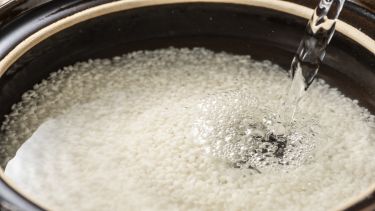- University of Sheffield study shows cooking rice in a certain way removes more than half of the naturally occurring arsenic compared to rinsing alone
- Study shows no loss of micronutrients for both brown and white rice during the recommended ‘home-friendly’ process
- Scientists call for further research on how to remove arsenic in areas of poor water quality and regional rice varieties
A new paper, released today in Science of the Total Environment shows that cooking rice in a certain way removes over 50 per cent of the naturally occurring arsenic in brown rice, and 74 per cent in white rice. Importantly, this new method does not reduce micronutrients in the rice.
Following previous research from the University of Sheffield that found half of the rice consumed in the UK exceeded European Commission regulations for levels of arsenic in rice meant for the consumption for infants or young children.
This new study tested different ways to cook rice to try and reduce the arsenic content and the team from the Institute for Sustainable Food found that by using a home-friendly way of cooking rice, the ‘parboiling with absorption method’ (PBA), most of the arsenic was removed, while keeping most nutrients in the cooked rice.
The PBA method involves parboiling the rice in pre-boiled water for five minutes before draining and refreshing the water, then cooking it on a lower heat to absorb all the water.
Arsenic, which is classified as a Group 1 carcinogen by the International Agency for Research on Cancer, is water-soluble - so it accumulates in rice, which is grown in flooded fields more than other cereals. Arsenic exposure affects almost every organ in the body and can cause skin lesions, cancer, diabetes and lung diseases.
Rice is known to accumulate around ten times as much arsenic as other cereals. In rice grains arsenic is concentrated in the outer bran layer surrounding the endosperm. This means that brown rice, (unmilled or unpolished rice that retains its bran) contains more arsenic than white rice. This milling process removes arsenic from white rice but also removes 75-90% of its nutrients.
For rice consumers, this is excellent news. There are genuine concerns amongst the population about eating rice due to arsenic. Previous studies have shown that cooking rice in excess water could remove arsenic but the problem is it also removes nutrients.
Our aim was to optimise the method to remove arsenic while keeping maximum nutrients in the cooked rice. Our newly developed method, PBA, is easy and home-friendly so that everyone can use it. We don't know the amount of arsenic in each packet rice we buy; even though brown rice is nutritionally superior to white rice as our data shows, it contains more arsenic than white rice. With our new method we are able to significantly reduce the arsenic exposure while reducing the loss of key nutrients.
We highly recommend this method while preparing rice for infants and children as they are highly vulnerable to arsenic exposure risks.
Dr Manoj Menon
Environmental Soil Scientist in the Department of Geography at the University of Sheffield and lead author of the study
The research was funded as part of the UK’s Science and Technology Facilities Council (STFC) Food Network+ along with partial financial support from School of Health and Related Research (ScHARR) at the University of Sheffield. The network brings together more than 750 international and multidisciplinary researchers from across the agri-food sector to work with experts from STFC’s research facilities, all with the aim of solving some of the world’s greatest food sustainability challenges. Until April this year, the network was led by the University of Manchester. This is now being led by academics at the Institute for Sustainable Food.
The Institute for Sustainable Food at the University of Sheffield brings together multidisciplinary expertise and world-class research facilities to help achieve food security and protect the natural resources we all depend on.
Media contact: Rebecca Ferguson, Media Relations Officer, 0114 222 3076, r.l.ferguson@sheffield.ac.uk

